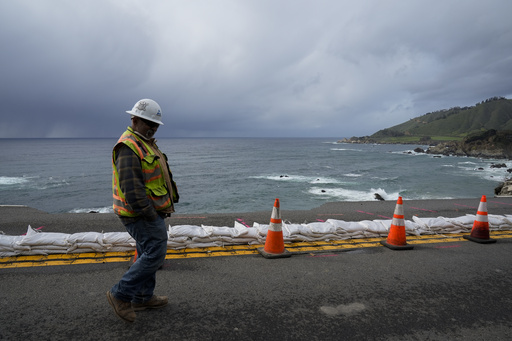BIG SUR, Calif. (AP) — A new storm swept into California on Thursday and again forced the closure of scenic Highway 1 in iconic Big Sur where one of its two lanes collapsed into the ocean after heavy weekend rains.
The Monterey County Sheriff’s Office had warned residents of the region to consider leaving before the highway was shut down Wednesday afternoon, especially if they have medical issues. The route was not expected to reopen until Saturday.
The California Department of Transportation had been cautiously running convoys of residents and essential workers past the slide area in both directions twice daily on the remaining undamaged lane.
Leaving the area requires heading north toward Monterey Bay because a 12-mile (19-kilometer) stretch of Highway 1 to the south has been blocked for some time by three previous slides requiring massive repair projects.
The San Francisco Bay Area weather office said the unusually cold storm arrived in the morning with brief heavy rain, hail, low-elevation snow and lightning. Snow also fell in the Sierra Nevada, where winter weather warnings and advisories were issued Thursday.
The Big Sur highway slide site got rain early in the day but there was little precipitation through the middle of the day. A second weather disturbance was expected in the area Friday, before heading toward Southern California.
The closure disrupted visitor Tammy Fisher’s trip from San Francisco to San Diego.
“One of our attractions was the Big Sur, but as you can see, we got a little hiccup,” Fisher said in an interview at a roadblock. “Now we’re gonna bust a U-turn and figure out where the detour will lead us.”
Big Sur is a 90-mile (145-kilometer) stretch of the state’s central coast where often misty, forested mountains descend to the ocean. Much of Highway 1 is perched on the edge of cliffs, presenting dramatic views that draw tourists. The route experiences frequent closures because of landslides stemming from severe weather.
The latest collapse occurred Saturday near Rocky Creek Bridge, about 17 miles (27 kilometers) south of Monterey, temporarily stranding as many as 1,600 people in Big Sur. Most were able to leave when the single lane was reopened Sunday, Caltrans spokesperson Kevin Drabinski said earlier this week.
Five California state parks in the area were closed indefinitely after the slide and local media reported that the Carmel Unified School District said the evacuation warning led to the closure of an elementary school and preschool on Thursday and Friday.
Engineers were to remain on site through the storms to watch for any changes, Caltrans said in a statement.
“Crews are continuing to focus on strategies to stabilize the edge of the roadway and work will continue once the rain event passes,” Caltrans said Thursday.
Total losses to Big Sur businesses since the latest slide have exceeded $1 million each day, Kirk Gafill, president of the Big Sur Chamber of Commerce, told the San Francisco Chronicle on Wednesday.
Work also continued at the sites of three other major landslides along the highway in Big Sur, Caltrans said.
About 300 miles (480 kilometers) to the northeast, parts of Interstate 80 in the Sierra Nevada were shut down Thursday afternoon after multiple semi-trailer trucks and passenger vehicles collided amid snowy conditions west of Lake Tahoe. There were no injuries.
Meanwhile a 40-mile (64-kilometer) stretch of I-80’s westbound lanes were closed from Truckee to the California-Nevada line as snow accumulated. Chains were required on tires of all vehicles headed east. Winter weather warnings and advisories were in effect into Friday morning, with 6 inches (15 centimeters) of snow possible in mountains and about a foot (30 centimeters) expected at higher elevations.
—-
Antczak reported from Los Angeles. Associated Press writer Scott Sonner contributed from Reno, Nevada.
Stretch of California Highway 1 that collapsed in Big Sur closes again as new storm arrives





